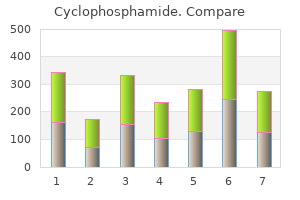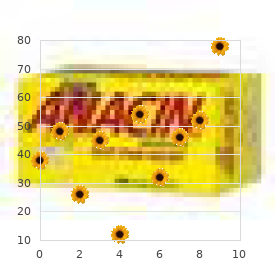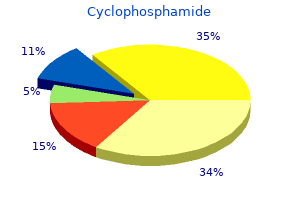Cyclophosphamide
"Buy generic cyclophosphamide 50mg, symptoms nasal polyps".
By: M. Irhabar, M.A., M.D.
Deputy Director, A.T. Still University School of Osteopathic Medicine in Arizona
Howevet; tumors have been associated to other exposures including nickel treatment 1 degree av block order cyclophosphamide 50 mg visa, chlorophenols 5 medications related to the lymphatic system order cyclophosphamide 50mg with mastercard, and textile dust natural pet medicine trusted 50mg cyclophosphamide. A distinct variant of nonkeratinizing squamous cell carcinoma occurs in this area treatment 247 order cyclophosphamide 50 mg on-line, the so-called cylindrical cell (Schneiderian or transitional) carcinoma. It has a papillary configuration with ribbons of invaginating tumor composed of pleomorphic cells with out keratinization. Primary non-salivary gland-type adenocarcinomas of the sinonasal region are uncommon. They have a powerful affiliation with long-term occupational exposures, specifically wooden mud (in carpenters), leather mud, nickel, or chromium compounds. As such, they stain primarily similar to gastrointestinal adenocarcinomas, so it can be very difficult to separate them from the rare metastasis to this region from a major gastrointestinal adenocarcinoma. These are uncommon tumors, most of which are low grade and have a predilection for the ethmoid sinuses. Low-grade tumors have a glandular or papillary progress sample with quite a few uniform, small glands organized back-to-back and lined by a single layer of cuboidal to columnar cells with a average amount of eosinophilic to pricey cytoplasm and spherical nuclei. There is just delicate nuclear pleomorphism, modest mitotic exercise without atypical varieties, and no necrosis. High-grade tumors sometimes happen within the maxillary sinus and have similar histologic features, but additionally have solid areas and show moderate to severe nuclear pleomorphism with brisk mitotic activity and necrosis. The prognosis for low-grade tumors is great, but for high-grade tumors is quite poor. Neuroendocrine carcinomas occasionally arise in the sinonasal region and are morphologically identical to those arising within the lung. High-grade neuroendocrine carcinoma (small cell carcinoma) is a rapidly proliferating, aggressive neoplasm that presents with epistaxis, nasal obstruction, and exophthalmos. It usually presents at a sophisticated stage with in depth local disease and lymph node or distant metastases. Primary malignant melanoma of the sinonasal tract constitutes approximately 1% of all melanomas. It is extra widespread within the nasal cavity than within the paranasal sinuses, and most sufferers are over 50 years old, with tumors most often occurring on the middle or inferior turbinate, or anterior septum. Although variable, the everyday macroscopic look is a sessile or polypoid lesion with mucosal ulceration. A junctional element with pagetoid spread of melanocytes in the intact mucosa is also generally present. Chapter 3 � Nasal Cavity, Paranasal Sinuses, and Nasopharynx I 45 Although metastases can recapitulate a main lesion, a junctional part within the floor mucosa essentially guidelines out metastasis. The prognosis for sinonasal melanoma could be very po01; with frequent local recurrence and distant metastasis. This unique tumor arises almost exclusively within the upper nasal cavity from the olfactory mucosa of the cribriform plate, higher lateral nasal wall, and superior turbinate. The presumed cell of origin is the reserve cell that provides rise to neuronal and sustentacular cells of the olfactory mucosa. The tumor happens at any age however mostly in the third and fourth many years, with symptoms of nasal obstruction, epistaxis, and anosmia. The neoplasm is normally a unilateral, polypoid mass, microscopically composed of small, round cells that are slightly bigger than lymphocytes. The nuclei are spherical, with uniform to delicately stippled chromatin without nucleoli. Some tumors have a really lobulated and nested progress pattern, whereas others have a diffuse sample. Some tumors have been reported to show vital nuclear pleomorphism and high mitotic activity. However, this is very uncommon and merits consideration of one other neoplasm, particularly high-grade neuroendocrine carcinoma. Rare findings embody ganglion cells, melanincontaining cells, and divergent differentiation together with glandular, squamous, and teratomatous features.
Proliferation markers are used at the aspect of mitotic counts in mind tumors to information dedication of tumor grade and prognosis treatment goals and objectives discount cyclophosphamide uk. Recently treatment molluscum contagiosum order cyclophosphamide with american express, a quantity of antibodies have been developed that can be utilized in lieu of extra sophisticated molecular exams for analysis and prognosis of varied neoplasms medications in carry on cheap cyclophosphamide master card. Diagnostically medications quotes cheap 50 mg cyclophosphamide amex, this immunohistochemical stain reveals best promise for its potential to distinguish lowgrade diffuse glioma from gliosis (Am J Surg Pathol. Prognostically, the presence of this mutation is favorable, as such tumors appear to show greater response to remedy. A few of these are pathognomonic for a given illness, however most ailments require a constellation of findings to suggest a diagnosis. When an axon is damaged and the related neuron survives, the axon itself might type a swelling, or axonal spheroid, on the web site of injury. If the axon is severed, in most cases the distal portion will disintegrate in an lively mobile process referred to as Wallerian degeneration. In some circumstances, the axotomized neuron will endure "chromatolysis," in which the cell physique seems mildly swollen and achromatic; this modification reflects a lack of Nissl substance that happens because the cell alters its metabolism to permit repair of its broken axon. If neuronal damage is severe sufficient to trigger cell death, neurons might undergo apoptosis (as occurs within the foundation pontis and subiculum from hypoxic ischemic damage late in gestation, a sample labeled with the misnomer pontosubicular necrosis). It is necessary to note that a standard artifact brought on by overmanipulation of contemporary brain tissue may cause regular wholesome neurons to (superficially) resemble pink neurons. Occasionally, damaged neurons across the edge of a distant infarct or traumatic harm turn into encrusted with basophilic iron and calcium salts. Binucleation of neurons, rare in regular brains, is sometimes famous in dysplastidmalformative processes. In Pick illness (a form of frontotemporal dementia), these are argyrophilic by Bielschowsky and Bodian (but not Gallyas) silver stains and are plentiful in neurons of the cortex, hippocampus, and dentate gyrus. A related (but less plentiful, Gallyas positive) inclusion is seen in corticobasal degeneration. These lesions (along with related inclusions [Lewy neurites] that seem inside cell processes) are seen in Lewy body problems. Hirano our bodies are brightly eosinophilic rod-shaped or elliptical cytoplasmic inclusions that happen inside the proximal dendrites of neurons, particularly within the hippocampus. Reactive astrocytes have distinguished stellate processes and, usually, ample eccentrically distributed glassy cytoplasm that inspires the moniker "gemistocyte. Grossly, tissues affected by persistent astrocytosis are usually agency; thus, the time period "gliotic" is used to describe mind tissues that appear unusually agency or rubbery. Bergmann gliosis refers to an accumulation of astrocytic nuclei (usually in affiliation with neuron loss) inside the Purkinje cell layer of the cerebellum. Corpora amylacea are basophilic, round, concentrically lamellated aggregates of polyglucosan (polyglucosan bodies) that develop inside astrocytic processes. Common in normal brains, significantly near ventricular and pial surfaces, these become more quite a few with age. Similar constructions (Lafora bodies) form in far higher numbers in astrocytes and neurons (and in eccrine sweat glands) in Lafora body illness. In response to varied alerts, these cells endure activation, whereupon they alter their morphology (appearing as irregular elongated "rod cells"), turn into motile, and intensify their communication with different cells by way of secreted elements. Small clusters of activated microglial cells (microglial nodules) are attribute of viral encephalitis and could additionally be seen adorning dying neurons, in a process known as neuronophagia. Capacity for phagocytosis will increase within the setting of damage, infection, or demyelinating illness when microglia differentiates into macrophages. Gliomas themselves typically comprise numerous microglial cells, which seem to play a role in tumorigenesis (Cancer Res. Depending on its pathogenesis, cerebral edema may be categorized as vasogenic, cytotoxic, osmotic, or interstitial (resulting from obstructive hydrocephalus). In vasogenic edema, the fluid collection is predominantly extracellular and results from breakdown of the blood-brain barrier. Osmotic edema outcomes when osmolality of the brain interstitial fluid exceeds that of the plasma.
Generic 50mg cyclophosphamide. Salamat Dok: Pneumonia | Discussion.

Other infections can produce specific histologic findings similar to viral inclusions (polyoma and herpesviruses) or granulomas (tuberculosis medicine 831 cyclophosphamide 50mg without prescription, fungal infections treatment chlamydia buy 50mg cyclophosphamide with amex, and schistosomiasis) medicine dropper order cyclophosphamide 50 mg without prescription. As noted above medicine jobs order cyclophosphamide mastercard, bacterial, fungal, or parasitic infections can lead to granuloma formation. This is an unusual side effect of cyclophosphamide therapy that results in intensive ulceration and hemorrhage that, if extreme, might require cystectomy. Adenovirus an infection (in immunocompromised individuals) can also produce the same sample. These forms of cystitis are most frequently seen with extended indwelling catheter use. The presence of such an inflammatory part in papillary cystitis can assist in making the often troublesome distinction from a low-grade papillary urothelial neoplasm. Such infiltrates are most frequently seen adjoining to invasive urothelial carcinoma, however in addition they happen in sufferers with allergic conditions and in sufferers with parasitic infections, each usually in affiliation with peripheral eosinophilia. This is an uncommon inflammatory dysfunction that predominantly affects middle-aged and aged ladies and leads to extreme intractable signs of culture-negative cystitis. Petechial submucosal hemorrhages or ulcers (termed Hunner ulcers) are normally evident cystoscopically. Clinical correlation is required in these circumstances as a outcome of the histological findings are, at most, in preserving with the medical impression of interstitial cystitis. The situation is thought to result from a defect within the capacity of histiocytes to degrade phagocytosized bacteria. The former is taken into account a traditional discovering within the trigone and bladder neck of females however can hardly ever be seen in males receiving estrogen remedy for prostate most cancers. In distinction, keratinizing squamous metaplasia is extra common in males in association with persistent irritation and is taken into account Chapter 22 � the Urinary Bladder I three 83 a big risk factor for the subsequent development of carcinoma (Eur Urol. In addition to the intestinal metaplasia sometimes seen in cystitis glandularis, intestinal metaplasia in the presence of a chronically irritated bladder can contain the bladder mucosa and lamina propria in a focal or diffuse method, resulting in an look virtually indistinguishable from colonic mucosa. This is a benign epithelial proliferation composed of cells resembling renal tubular epithelium (hence the name), which usually arises within the setting of persistent irritation or harm such as infection or calculi (Adv Anat Pathol. The lesion was believed to be metaplastic, but more recent evidence has demonstrated that, a minimum of in renal transplant recipients, nephrogenic metaplasia is derived from shed renal tubular epithelial cells that may attach to areas of prior injury. Nephrogenic metaplasia is normally an incidental finding, however it may additionally present as a mass lesion simulating most cancers. The importance of nephrogenic metaplasia lies in the reality that within the bladder it can be confused with adenocarcinoma (especially clear-cell adenocarcinoma) and glandular variants of urothelial carcinoma (Mod Pathol. This change may be seen after radiation therapy, chemotherapy, or unassociated with either therapy (Arch Pathol Lab Med. The irregular nests and aggregates might appear to wrap round ecstatic vessels with fibrin thrombi, which is a useful diagnostic discovering. Usually seen in a setting of acute and/or continual irritation, reactive atypia could also be related to hyperplastic or thin urothelium. Mitotic figures could also be elevated and cell crowding could additionally be observed; nevertheless, polarity, cell uniformity, and maturation are usually well preserved. Most regularly seen on the serosal aspect of the bladder in ladies with a previous history of pelvic surgical procedure, foci of endometriosis can even involve the lamina propria or muscularis propria and could also be seen cystoscopically. Nns Squamouo Cldl poplbna - Chapter 22 � the Urinary Bladder I 38 5 epithelium (very much like so-called "prostatic urethral polyps" of the urethra). The floor urothelial lining is normal and there may be tubular or anastomosing urothelium. These polyps have a broader fibrovascular core than urothelial papillomas and lack the edema and irritation of polypoid cystitis. Histologic typing and diagnosis of urothelial abnormalities are accomplished by examination of H&:E-stained sections. In addition to reactive atypia discussed earlier, such lesions embody urothelial dysplasia and urothelial carcinoma in situ. Occasionally, it may be tough to distinguish urothelial dysplasia from reactive atypia; in such conditions a diagnosis of atypia of unknown significance may be warranted.


Clinical: A single red symptoms of anxiety 50mg cyclophosphamide with mastercard, scaly plaque on sun-damaged pores and skin (arms and chest/shoulders); the scientific impression is regularly that of a basal cell carcinoma or different nonmelanoma pores and skin cancet medications ending in pam cyclophosphamide 50 mg fast delivery. Skin findings medications 512 buy discount cyclophosphamide 50mg, which range with the scientific illness medications on a plane buy cyclophosphamide 50mg amex, embrace a "butterfly" -shaped erythematous rash on the cheeks and nostril, scaly erythematous lesions on sun-exposed skin and/or scarring, and alopecic plaques. Direct immunofluorescence of a well-established lesion normally reveals linear-granular immunoglobulin G (IgG), IgM, and/or complement deposition on the basement membrane. Because the method is mediated by lymphocytes, lymphocytes in the epidermis and superficial dermis are required for the analysis. Clinical: It has numerous medical types (vulgaris, pustular, erythrodermic, guttate), the most common being psoriasis vulgaris, which presents as erythematous plaques with a thick scale on the extensor surfaces (knees, elbows). Guttate psoriasis is commonly extra acute and has many raindroplike, mildly scaly papules. Guttate psoriasis has mounds of parakeratosis, however lacks the common acanthosis of psoriasis vulgaris. Clinical: Thick, hyperkeratotic (and typically hyperpigmented) plaques, generally on the again of the neck, extensor forearms, and legs, or genital region, attributable to continual rubbing or scratching. Microscopic: Compact orthokeratosis, a thickened stratum granulosum, thick and elongated rete. The papillary dermis characteristically has collagen fibers that run towards the pores and skin floor (so-called vertical streaks). Other entities with a psoriasiform pattern embody dermatophytosis, pityriasis rubra pilaris, mycosis fungoides, and chronic spongiotic dermatitis. Spongiotic: Characterized by expanded house between adjacent keratinocytes of the spinous layer. Acute spongiosis has spongiosis and vase-shaped vesicles but no or minimal parakeratosis; subacute spongiosis has definitive parakeratosis; chronic spongiosis has psoriasiform hyperplasia and areas of compact orthokeratosis combined with parakeratosis. Clinical: Erythematous scaly patches or plaques, variable distribution, any age/gender; age/gender and distribution range with the inciting agent; atopic dermatitis in kids is classically periflexural. Microscopic: Parakeratosis, spongiosis, variable acanthosis, and a superficial perivascular inflammatory infiltrate which may be purely lymphocytic or could have lymphocytes blended with other inflammatory cells such as eosinophils; the diploma of change is determined by the chronicity of the lesion. Clinical: Scaly erythematous patches/plaques; classically distributed in a "Christmas tree-like" pattern on the back; much less frequent patterns exist, together with lesions on the extremities (inverse pityriasis rosea). Microscopic: Mounds of parakeratosis, irregular acanthosis, patchy spongiosis, and a mild superficial perivascular lymphocytic infiltrate with extravasated erythrocytes. Prominent exocytosis of lymphocytes is occasionally current and erythrocytes could prolong into the epidermis. Etiologies embrace allergic contact dermatitis, arthropod bite reactions, drug eruptions, the urticarial section of pemphigus or pemphigoid, and the first stage of incontinentia pigmenti. Other entities that have a spongiotic tissue pattern embody early and partially treated psoriasis and mycosis fungoides. Clinical: Tense blisters on an erythematous base, could also be pruritic, could also be generalized, normally within the aged. Variants embrace pemphigoid gestationis, which happens in being pregnant, and cicatricial pemphigoid, which has mucosal involvement and resolves with mucosal scarring. Direct immunofluorescence exhibits linear deposition of IgG and C3 on the basement membrane zone. Indirect immunofluorescence can also be useful for analysis and to observe response to remedy. Clinical: Blistering of sun-exposed pores and skin, particularly palms and face; milia (small subepidermal cysts) might develop. Clinical: Highly pruritic, small vesicles and/or excoriations on the extensor surfaces (elbows, knees, and buttocks/sacrum) associated with gluten sensitivity. Granulomatous: Characterized by a variable quantity and arrangement of epithelioid histiocytes. Clinical: Clinically variable; lesions could also be localized or generalized, annular and erythematous, papules, plaques or patches, subcutaneous nodules or perforating. Microscopic: Epithelioid histiocytes palisade around dermal collagen with nuclear dropout; there could also be an associated lymphocytic infiltrate, and interstitial mucin may be elevated within the heart. The interstitial variant has much less definitive architectural features and may appear at scanning energy as a vaguely patterned, hypercellular dermis. Clinical: A continual plaque with a depressed yellow middle and an erythematous, raised rim/border, normally pretibial; feminine predilection; may be related to diabetes. Microscopic: Dermal collagen is fibrotic; layers of fibrosis alternate with zones of histiocytes and plasma cells.

